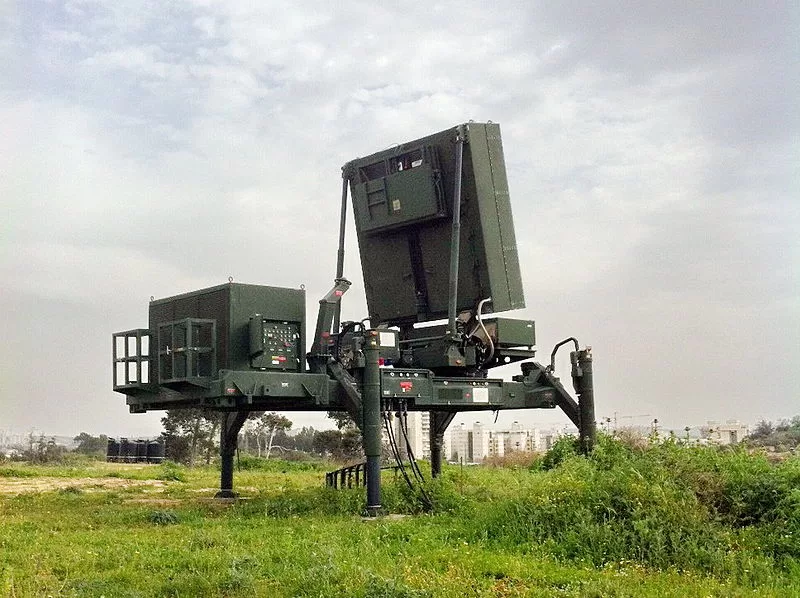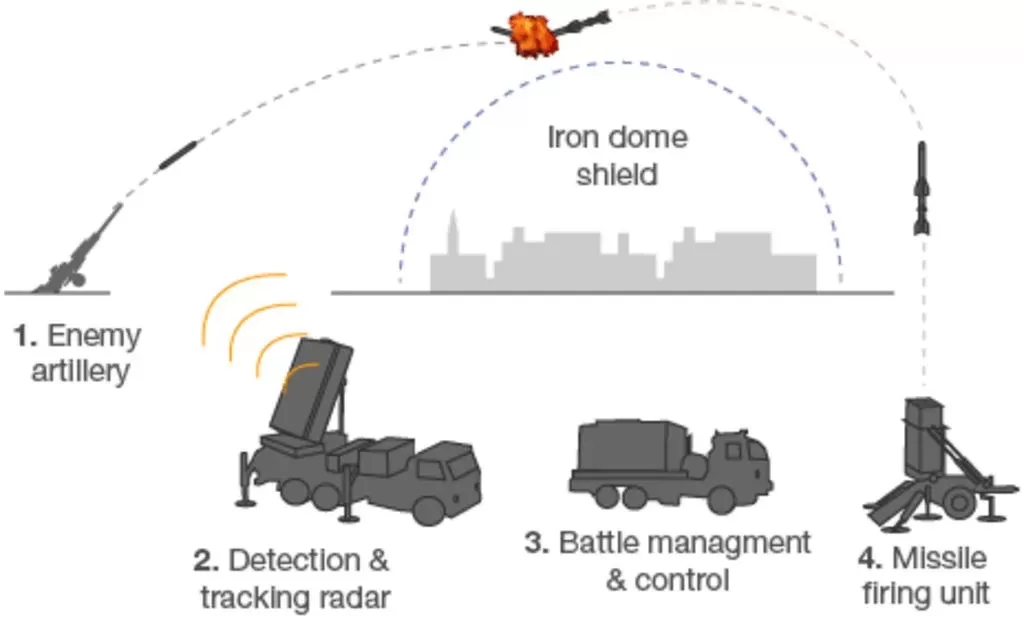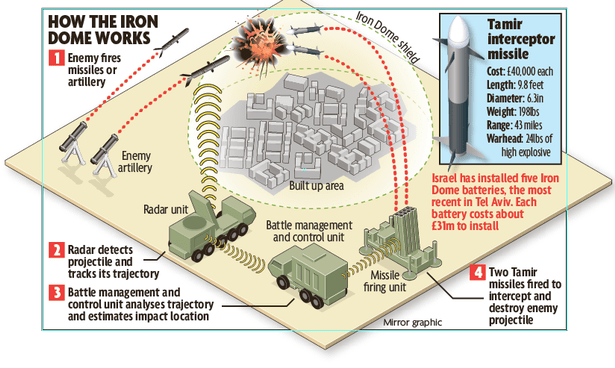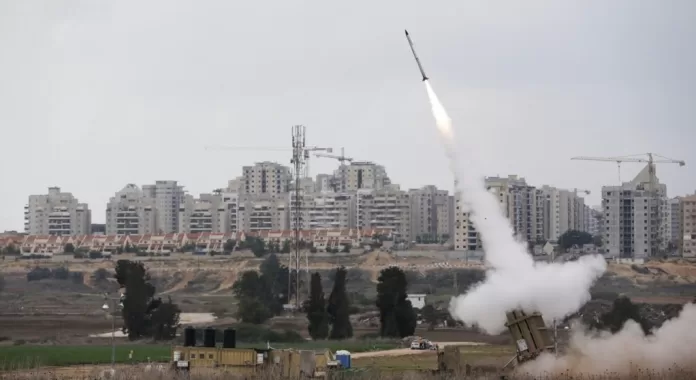Iron Dome is the latest and smallest of Israel’s anti missile systems, also known as Iron Cap. It is a mobile all-weather air defense system developed by Rafael Advanced Defense Systems Ltd., in conjunction with the Israeli Defense Forces (IDF). Designed to intercept incoming rockets, long-range artillery fired from distances of 4 to 70 kilometers away and destroy them in the air before they reach populated areas.
In 2007, then-Israeli defense minister Amir Peretz announced that Iron Dome was the government’s choice for dealing with the threat from short-range missiles. Iron Dome was first deployed in March 2011 to thwart missiles being launched into Israel by Hamas in Gaza.
Iron Dome has three components: the detection and radar installation, battle management and weapons control (BMC), and the missile firing unit.
The radar system detects opposing missiles or artillery shells when they are launched.
The BMC is the brain of the system. It calculates the trajectory of the rocket and where it is expected to hit. The BMC is capable of tracking and firing at multiple targets simultaneously.
If an incoming rocket is headed to a low-risk area, like an empty field, Iron Dome will leave it alone. But if a rocket is on a path to a sensitive target, like a populated area, Iron Dome launches a Tamir missile that can intercept it.
The system also figures out the best place to intercept the incoming target along its trajectory, to try and avoid debris falling on populated areas.
The Tamir interceptor missiles cost about US $ 40,000 each, and can be fired day or night and in any type of weather. They are guided for the first part of their flight by the radar system and BMC on the ground, which keeps them on course.
When the Tamir nears its target, the missile’s own onboard radar takes over. The warhead it carries explodes, destroying both the Tamir and the incoming target.
The Iron Dome installations can be moved by a truck, and typically have a radar unit controlling three launchers. Fully loaded, each launcher contains 20 missiles.
The system uses technology first employed in Rafael’s SPYDER system.
Iron Dome was initially deployed in March 2011 near Beersheba. In April 2011, the system successfully intercepted a Grad rocket launched from Gaza for the first time.
During the 2006 Second Lebanon War, approximately 4,000 Hezbollah-fired rockets landed in northern Israel.
Between 2000 and 2008 more than 4,000 rockets and 4,000 mortar bombs were fired into Israeli population centres, mainly by Hamas. Nearly 1,000,000 Israelis living in the south are within rocket range.
In February 2007, Defense Minister Amir Peretz selected the US$ 210 million Iron Dome as Israel’s defensive solution to this rocket threat. In 2013, the Iron Dome is expected to be extended by the Rafael Magic Wand system, designed to intercept medium-to long-range rockets and cruise missiles, such as those possessed by Hezbollah, fired at ranges from 40 km to 300 km.
The initial funding and development of the system was provided by Israel. This allowed for the deployment of the first two Iron Dome systems. Subsequently, funding for an additional eight Iron Dome systems—along with funding for a supply of interception missiles—is currently being provided by the United States.

After President Obama arrived in Israel, in March this year, his first stop was to inspect an installation of Iron Dome, near Tel Aviv airport. The installation built with the help of American money, came with considerable symbolism as Obama showed support for Israel after years of tensions over Jewish settlements and how to curb Iran’s nuclear ambitions.
Unstated amid the good will, though, was an intensifying debate over whether Iron Dome’s claims of warhead destruction were more illusory than real.
Israeli officials initially claimed success rates of up to 90 percent. Michael Oren, Israel’s ambassador to the United States, hailed the antimissile system as the first to succeed in combat. Congress recently called the system “very effective” and pledged an additional $680 million for deployments through 2015.
The system’s maker, Rafael, says that the interceptor is designed “to ensure destruction” of the enemy warhead. That is precisely the claim critics have challenged.
A number of weapons experts in the United States and in Israel say their studies — based largely on analyses of hits and misses captured on video — suggest that Iron Dome destroyed no more than 40 percent of incoming warheads and perhaps far fewer. Many rockets, they argue, were simply crippled or deflected — failures that often let intact or dying rockets fall on populated areas.
Richard M. Lloyd, a weapons expert who has written a critique of Iron Dome for engineers and weapons designers, said of the system’s makers “But the problems go on and on.”
After the Gaza cease-fire last year, Lloyd began scrutinizing hundreds of online videos of Iron Dome in action. He was looking for unambiguous signs of success: pairs of fireballs (at night) or smoke clouds (during the day) that formed as speeding fragments blew up a warhead, but found very few.
His method of video analysis won scientific backing long ago. During the 1991 Persian Gulf war, the American military boasted that Patriot interceptors, built in the United States, had succeeded 96 percent of the time. But M.I.T. scientists analyzed broadcast videos and found only misses. Slowly, the Army retreated.
Lloyd also has written two books on anti missile warhead design during his two decades at Raytheon, a top antimissile contractor. His doubts deepened as he saw images of interceptors racing helter-skelter in the sky and found photographs of fallen rockets and even intact warheads. From such evidence, as well as from rocket and warhead basics, Lloyd estimates that the system succeeded 30 percent to 40 percent.
In Israel, Lloyd won support from Dr. Reuven Pedatzur, a military analyst, former fighter pilot and professor of political science at Tel Aviv University, long skeptical of his country’s antimissile claims. Dr. Pedatzur found an Israeli police report saying that 109 rockets launched from Gaza — roughly twice the military’s figure — hit urban areas.

In 2010, Iron Dome was criticized by Pedatzur, for costing too much compared to the cost of a Qassam rocket (fired by Palestinian forces), so that launching very large numbers of Qassams could essentially attack Israel’s financial means. The estimated cost of each Tamir interceptor missile is US$35,000–50,000 whereas a crudely manufactured Qassam rocket costs around $800. Rafael responded that the cost issue was exaggerated since Iron Dome intercepts only rockets determined to constitute a threat, and that the lives saved and the strategic impact are worth the cost.
Dr. Theodore A. Postol, a physicist at Massachusetts Institute of Technology, helped reveal the Patriot anti missile failures of 1991, analyzed the videos and found that Iron Dome repeatedly failed to hit its targets head-on. “It’s very hard to see how it could be more than 5 or 10 percent,” Dr. Postol said.
The Israeli Institute of National Security Studies published a rebuttal to these claims, raising serious doubts about Postol’s methods and conclusions.
Postol says that it might have been “a reasonable strategy for Israel to claim that Iron Dome was working, as an excuse not to invade Gaza at an enormous cost to both sides.”
Mordechai Shefer, an Israeli rocket scientist formerly with Rafael, Iron Dome’s maker, studied nearly two dozen videos and, in a paper in February 2013, concluded that the kill rate was zero.
According to weapon experts, most of the explosions appear spherical, which indicates that the interceptor missile warhead is exploding, and that this is not a secondary explosion of the rocket’s warhead. Otherwise, they contend, there would have been two explosions visible, or at least something asymmetrical. They also identified Iron Dome interceptors exploding shortly after they made a sharp turn. In their opinion, this was a pre-programmed trajectory and not pursuit of a target.
“The report’s claims appear puzzling, particularly the contention that Iron Dome did not succeed in causing the rocket’s warhead to explode. This claim is reminiscent of claims from the 1991 Gulf War, directed then at the Patriot missiles, which in fact were not successful in hitting the Scud warheads, for the simple reason that the Patriot was designed to intercept and shoot down planes, not missiles.” Yiftah Shapir, INSS researcher commented.
Indian Defense planners were keeping a close watch on the performance of the Iron Dome during the 2012 Operation Pillar of Defense. Several months ago, the military scientists in the Defence Research and Development Organisation (DRDO) had suggested that India look at a joint development programme with Israeli firms to develop an Indian version of Iron Dome.
DRDO is currently collaborating with Israeli firms to develop medium range surface to air missiles (MRSAMs) and LRSAMs. According to reports, there have been talks between DRDO and their Israeli counterparts for a possible joint development of Iron Dome for India.
One of the reasons why some Indian defense planners were pushing for it is the possibility of another war with Pakistan, where the Iron Dome would be useful to deter even conventional artillery attacks. In addition, they say Pakistan has developed a tactical nuclear weapon system the Nasr system, which is a solid fuelled battlefield range ballistic missile.

In February this year, India rejected the Israeli offer of the Iron Dome system, saying it was not suitable for the service. The Chief of Staff of the Indian Air Force Norman Anil Kumar Brown at the international air show “Aero India 2013” held in Bangalore, stressed that the “Iron Dome” does not meet India’s demands.
Israel and India maintain close security cooperation and defense ties. In March 2011, India signed a $1 billion deal with Rafael and Israel Aerospace Industries signed a $2.5 billion deal with India in 2007 to develop anti-aircraft and missile systems.
In February, this year, India and Israel jointly established a company for the development and manufacture of anti-missile system of medium range missiles with the capacity to strike at a distance of 70 km. The cost of the project was 2.2 billion USD. The project involves India’s Defense Research and Development Organization and Israeli companies Rafael and IAI. Alongside, India develops positional anti-missile defense system independently; the first phase of the programme is scheduled to be accomplished in 2013 – 2014.
In India’s context, the weapon system is ineffective and a waste of money.
The size of Tel Aviv is just about 176 sq km with about 52 sq km estimated to have been targeted by the Palestine. The National Capital Territory of New Delhi, in comparison, is spread over 1,483 sq km.
Secondly, Iron Dome engaged one of the world’s most obsolete Qassam rockets. These rocket’s are build with outdated technology, making them easier to intercept. Hence the system is yet to prove its mettle against current rockets which India has to confront.
Other possible foreign sales:
NATO: On 10 March 2010, The Jerusalem Post reported that the Israeli Ministry of Defense was in talks with a number of European countries about the possible sale of the system in order to protect NATO forces deployed in Afghanistan and Iraq.
South Korea: During a visit to Israel in the summer of 2011, Kwon Oh-bong, Vice Commissioner of the Defense Acquisition Program Administration in Seoul, expressed interest in the system to counter the threat posed by North Korean artillery, rockets, and missiles
- Enemy fires missile or artillery shell
- Projectile tracked by radar. Data relayed to battle management and control unit
- Data analysed and target co-ordinates sent to the missile firing unit
- Missile is fired at enemy projectile
References
- IHLS, Israel Homeland Security, 23, March, 2013
- NYT, 21 March, 2013. Pg A 11.
- Reuters –Tel Aviv, March, 20, 2013
- Wikipedia
- bbc.co.uk/news/world-middle-east-21751766
- CBC, 20, November, 2012
- Daily Mirror, UK, 21 November, 2012
- Aerospace Research Analysis Wing, India, 8 February, 2013
- UPI.COM. New Delhi, 5 February, 2013
- Asian Defence, 25 November, 2012





